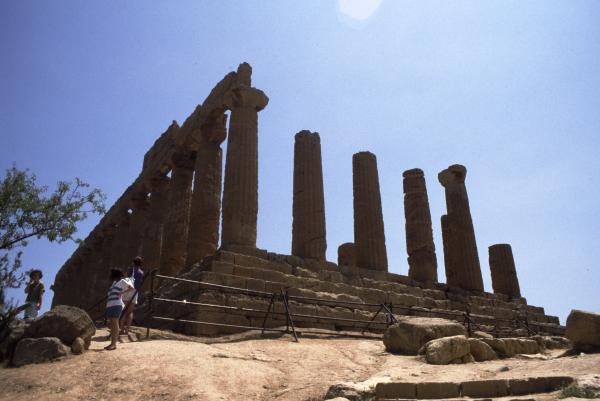The Island of Sicily was the boot of Italy in more ways than one. It has been the subject of conflict for millenium. Numerous tribes fought for control of port side villages, sea lanes, and staging grounds to mainland Italy. The Phoenicians , Spartans, Athenians, Southern Italian tribes all wanted control and access. The Southern coast was wealthy from trade, fishing and agriculture. Heraclea Minoa, Akragas and Gela were all prosperous cities. Syracuse on the Western shore was larger and more prosperous and had tight links to its Grecian roots. Akragas was rich, but less so than Syracuse, each had been ruled by related Tyrants Theron and Gelon (brothers) during the earlier Sicilian war (480 BC).
In 490 BC the Second Sicilian war was initiated by Carthage as a means to expand their meagre possessions on the isle. justified or not it was an expansion play for a state eager to grow northwards. Allied with Elymians they fought the Dorian Greeks. Akragas had been founded just 176 years earlier by Rhodians and Cretans.
“The political landscape in Sicily also changed as Greek tyrants were replaced by democracy and oligarchy, the domain of Syracuse shrunk and infighting between Greek cities flared up in Sicily. Athens had sent fleets to Sicily in 427, 425 and 424 BC to intervene, which caused Hermocrates of Syracuse requesting all Sicilian Greek cities to remain at peace at the congress of Gela in 424 BC.
The Elymian city of Segesta had clashed with Selinus over territorial rights and marriage issues, and had been worsted in the conflict. After an appeal to Carthage was turned down in 415 BC, Athens heeded the plea for help and sent over an expedition that was ultimately defeated at Syracuse in 413 BC. Faced with renewed hostility from Selinus, Segesta again appealed to Carthage in 410 BC. The Carthaginian Senate, after some debate, agreed to intervene. This appeal came at a time when the mainland Greek cities were locked in the Peloponnesian War, and Syracuse, an alley of Sparta, was not focused on Sicily.” [1]
The 2nd Battle of Himera 409 BC was fought in Northern Sicily, between the Carthaginian forces under Hannibal Mago (A king of Carthage of the Magonid family, not “The Hannibal!”) and the Ionian Greeks of Himera aided by an army and a fleet from Syracuse. Hannibal, acting under the instructions of the Carthaginian senate, had previously sacked and destroyed the city of Selinus after the Battle of Selinus in 409 BC. Hannibal then attacked the city of Himera, site of the great Carthaginian defeat of 480 BC and utterly destroyed that place. He wrought terrible revenge for the disgrace brought upon his family. Himera was never rebuilt, a new city of Thermae was built to the west of the ruined city, which contained a mixed population of Greeks and Phoenicians. So says the Wiki. There was an element of revenge and retribution in this battle which you can read about here http://wp.me/p1yz7I-75VzmP and the follow on post as well to see how all that ended up.
Fast forward 3 years:
The Siege of Akragas took place in 406 BC in Sicily; the Carthaginian siege ultimately lasted a total of eight months. The Carthaginian army under Hannibal a Magonid ostensibly besieged the Dorian Greek city of Akragas in retaliation against Greek raids on Punic colonies in Sicily.
During the siege, Hannibal and a large number of Carthaginian soldiers had perished of plague, and the survivors were in dire straits after the Greeks managed to cut their supply lines.
The city had managed to repel Carthaginian attacks until a relief army from Syracuse defeated part of the besieging Carthaginian army sent to thwart the Relief. That Battle of Arkagas was hard fought but it was only part of the total Punic forces. The Strategos, Dephnaeus did not follow onward with this success, rather he secured the city. The siege was lifted. Himilco and his army were still in the area however.
Politics and Tyranny played their part. Upon hearing that Dephnaeus had not pursued the Punic forces, several officers were stoned and the Strategos was disgraced.
“Justice” exacted the Greeks joined forces set about setting siege Himlico’s camp. Greek supply was cut off by superior Punic naval forces.
This caused first the Sicilian detachment, then most of the population of Akragas to leave the city, enabling Himilco to capture and sack the Akragas of its vast riches.
The consequences whilst not directly related, highlight that the age of the Tyrant as a intermediary period between the Classical and Hellenistic Periods was coming to an end. The constant turmoil and changes in leadership took its toll economically and politically upon the land and its people.
With the Greeks failure to follow up their success near Akragas, this meant the city was ultimately destroyed, with it the expansion of Punic interests continued.
Syracuse and the other city states were without support from mainland Grecian tribes. Sparta was ascendant and a threat to Thebes and Athens, all eyes turned inwards within the Grecian states. This was the beginning of the end of the Classical era, and within 50 years we would see the Rise of Macedon with Phillip at its head.
The era of the Hellenes was upon us.

Part Two shall deal with the battle itself using a simulation. The only question that remains is will history repeat itself?
Thanks for including an accurate map showing the location of Himera.
you are welcome…at least I hope it is accurate.!!!